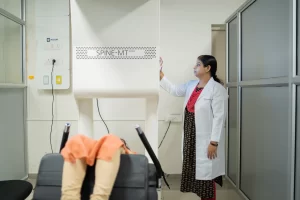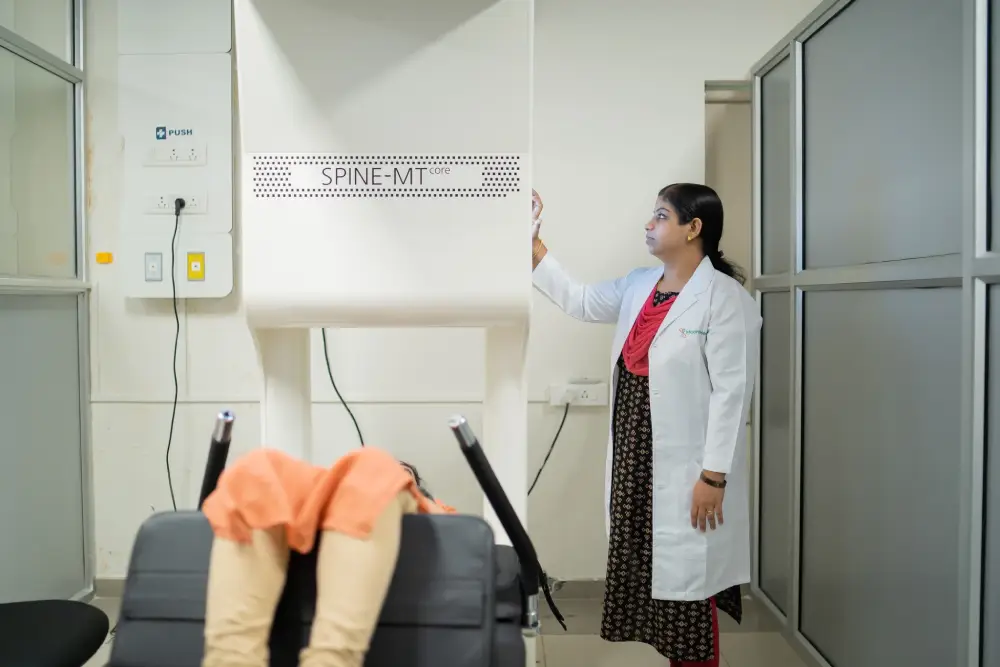What is Disc Herniation?
Discs support the bones that make up the spine present in our backs. The nucleus is surrounded by a tough outer layer (annulus) that is round, like a small pillow. Discs are known to be absorbers of shock waves for the spinal bones, which are said to be located between each vertebra in the spinal column.
A herniated disc (also known as a bulged, slipped, or ruptured disc) is a disc nucleus fragment that has been pushed out of the annulus and into the spinal canal because of a tear in the annulus. Disc Herniation is usually in the beginning stages of degeneration. The space in the spinal canal is not termed sufficient to compensate the spinal nerve and the displaced herniated disc fragment. The disc presses on spinal nerves as a result of this displacement, causing pain that can be severe.
Herniated discs can appear anywhere along the spine. Discs Herniation usually affects the lower back (lumbar spine), but it has also proven effective in affecting the neck (cervical spine). The location of the pain is determined by which part of the spine is affected. Get herniated discs treatment in Kerala from Maana Health.

Causes
A disc herniation is said to be caused by only strain or injury. However, as one gets older, disc material degrades and the ligaments that hold it in place weaken. A minor strain or twisting movement can cause a disc to rupture as the degeneration progresses.
Certain people are more susceptible to disc problems, and as a result, herniated discs can occur in multiple locations along the spine.
When and How Should You Seek Medical Help?
The majority of herniated discs do not necessitate surgery. In about 9 out of 10 people, the symptoms of sciatica/radiculopathy improve over time. The length of time it takes to improve varies from a few days to a few weeks.
General Instructions
For the next two to three days, limit your activities. Walking as tolerated is encouraged, as is the use of an anti-inflammatory such as ibuprofen if the patient is not allergic to it. Bed rest is not advised.
During this time, a primary care evaluation may lead to consideration of other non-surgical treatments, such as physical therapy, as listed below.
The American College of Radiology does not recommend radiographic imaging, such as an MRI unless symptoms have been present for six weeks.
If symptoms last longer than four weeks, you can contact one of our centers, Maana Health. Advanced imaging, such as an MRI, can be requested before an appointment if needed.
If you have symptoms of significant leg/arm weakness, loss of feeling in the genital/rectal region, no control of urine or stool, a history of metastatic cancer, a recent infection or fever AND radiculopathy or a fall/injury that caused the pain, you should get an evaluation and imaging right away. For exam findings of progressive neurologic deficit (such as progressive weakness), imaging should be considered earlier.
Treatment
Treatments that do not require surgery
A herniated disc is usually treated conservatively and without surgery at first.
Your doctor might suggest physical therapy for reducing your pain. Physical therapists can show you positions and exercises designed to minimize the pain of a herniation.
Pain killers may relieve the pain temporarily, but it does not cure in all cases. Most of these problems may be managed without surgery with physical therapy. If it is an acute case (less than 6 months) icing is recommended to reduce the muscle ache. IFT, Ultrasound, and TENS are the electrotherapy modalities in physiotherapy management. Neural mobilization is very effective to relieve tingling and numbness in the lower limbs.
Our Spinal Wellness Program in Kochi is a combination of manual and advanced therapeutic modalities, specific to individual patient conditions and diagnoses. Spinal decompression is an advanced version of traction which allows a negative pressure of -150 to -200 mm Hg to help the disc shrink to its original shape. It applies computer-controlled pulling forces at precisely measured angles to gently distract specified spinal segments. This distraction in the joints relieves pressure within the disc and any pinched nerves which promotes the movement and absorption of fluids and nutrients in the disc space. These fluids and nutrients are adequate to maintain disc health. Progressively these mechanisms can help to relieve pain.

Back ergonomic guidance and correction are critical for proper rehab and are extremely important for backache management as it helps in preventing recurrence. This consists of proper postural habits, a proper work environment, back exercises, and modifications in activities of daily living.
Conclusion
If left untreated, a herniated disc can deteriorate. This is especially true if you continue to engage in the activities that led to it — for example, if it arose as a result of your work. Chronic (ongoing) pain and loss of control or sensation in the affected area can result from a worsening ruptured disc.

